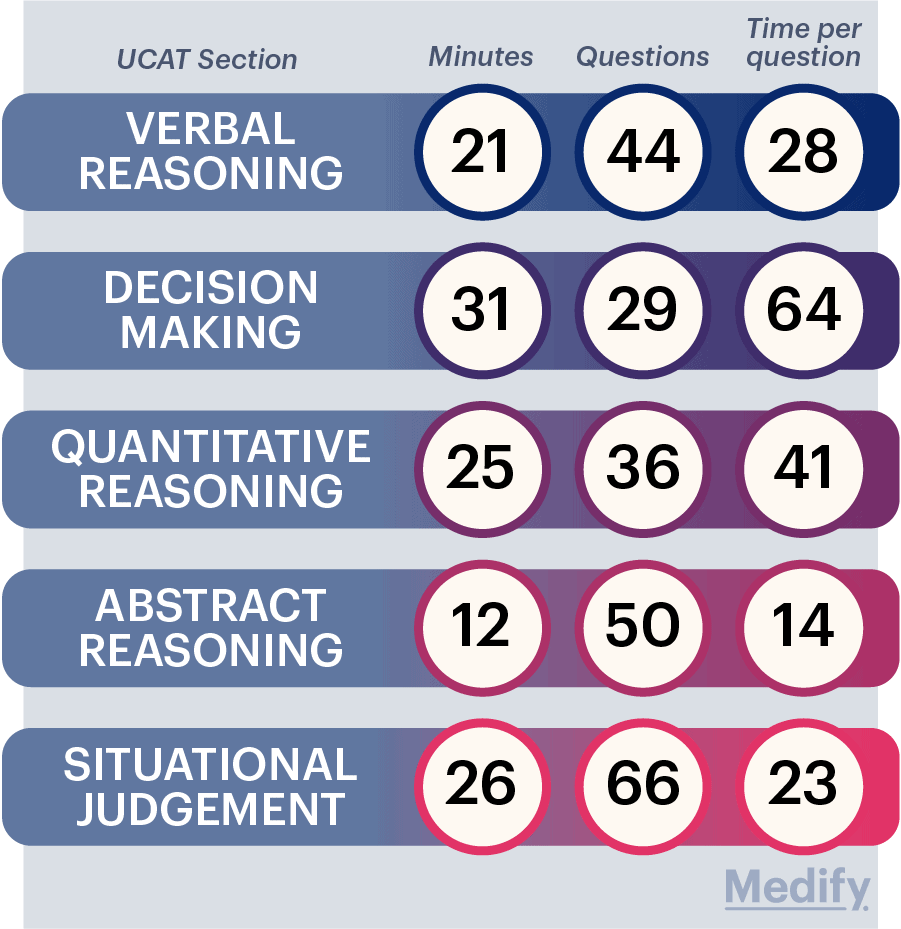The University Clinical Aptitude exam (UCAT), previously UKCAT before it was also introduced to Australia’s medical application process, is a notoriously demanding test. It is made up of four sections which contribute to an overall number score and a fifth section which places students in a band, ranging from 1 to 4. Whilst the questions aren’t extremely difficult, the time allocated is what really makes the exam a grueling one. On average students are given 33 seconds per question. The entire exam is multiple-choice.

Verbal reasoning
The first section of the test is verbal reasoning which the UCAT consortium has designed to assess “your ability to critically evaluate information presented in a written form.” This section is made up of 44 questions with 21 minutes allocated to the whole section. There are 11 passages of texts in total so four questions are asked about each passage. These can range from true, false, and can’t-tell questions to questions that ask students to make inferences or draw conclusions based on the text. This is generally the section students score lowest on because the text is quite a large chunk (which isn’t possible to fully read in the time available) and the inferences that can be made are subtle and hard to pick up. Each student has their own take on how this section should be answered and it’s important to find what works for you. Some say that you shouldn’t read the text and instead scan the question first, look for what it’s asking, and then scan the text for keywords to choose the right option. Whilst this is time effective, often the text might mention one topic more than once in different places which can be difficult to pick up on, so you can fall into the trap of making a mistake. On the other hand, if you quickly read through the text, then for the four questions you get on each text, you won’t have to keep flicking between the text and the question. However, one indisputable tip to use is to read as much and as often as you can. Reading a wide range of texts and genres, not only improves your vocabulary, but it allows you to get used to different contexts and gives you the chance to work on the speed of your reading.
Decision-making
This section contains 29 questions with 31 minutes to answer. So it’s not as tight for timing as the first section. The questions may contain text, charts, tables, graphs, or diagrams. A new question that has been recently introduced is syllogisms. Students are given a statement, it may refer to real things or something make believe eg ‘All bungles are tall. Some bungles are also wangles. But not all wangles are bungles and not all wangles are tall’ Then there will be four or five statements underneath to which you have to answer yes or no using a drag-and-drop method. For example, they may say ‘All wangles that are tall are also bungles’. You have to logically apply the statement given to deduce whether this is true or false and then answer the question. It can often be quite tricky to get your head around especially when there are complex and abstract statements given. There will also be questions where you will be given information about for example about 5 people, their jobs, their houses, and their pets. But you have to figure out which job, house, and pet belongs to each person based on a certain number of clues or information given. Towards the end, there are maths questions like Venn diagrams and probability questions which get better with practice.
Quantitative reasoning
This section is made up of 36 questions with 25 minutes. This question is composed completely of maths questions which are of GCSE level. This section requires practice and speed more than anything.
Abstract reasoning
Here, you will be given 50 questions to answer in 12 minutes. There are 5 questions in each question set and you will be given 10 question sets in total. There are 4 types of questions you will see, according to the UCAT consortium:
-
- For type 1, you will be presented with two sets of shapes labeled “Set A” and “Set B”. You will be given a test shape and asked to decide whether the test shape belongs to Set A, Set B, or Neither.
- For type 2, you will be presented with a series of shapes. You will be asked to select the next shape in the series.
- For type 3, you will be presented with a statement, involving a group of shapes. You will be asked to determine which shape completes the statement.
- For type 4, you will be presented with two sets of shapes labeled “Set A” and “Set B”. You will be asked to select which of the four response options belongs to Set A or Set B.
Situational judgment test
This section for me was the least pressured and was the only one where I had a lot of time left. It’s made up of 66 questions to be answered in 26 minutes. This section relates to ethics and you will be given possible scenarios you may face as a medical student or doctor and then be asked to rank how appropriate or inappropriate a possible response to each situation is.
Photo: ozok/Shutterstock
You might also like:
Support us!
All your donations will be used to pay the magazine’s journalists and to support the ongoing costs of maintaining the site.
Share this post
Interested in co-operating with us?
We are open to co-operation from writers and businesses alike. You can reach us on our email at [email protected]/[email protected] and we will get back to you as quick as we can.










